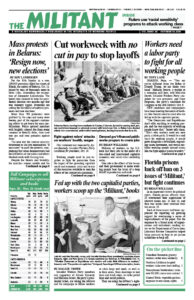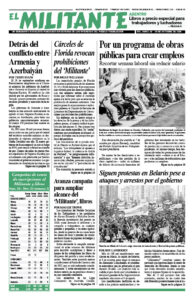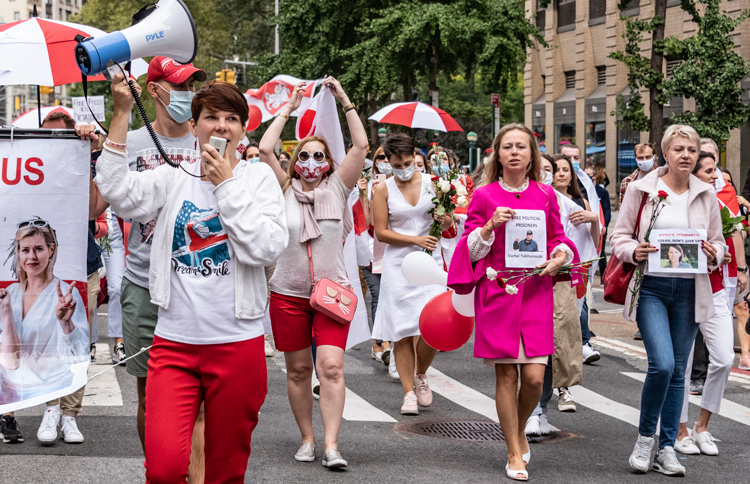For the 10th Sunday in a row, 100,000 protesters filled the streets of Minsk, the capital of Belarus, Oct. 11, joined by tens of thousands more in other cities, demanding the resignation of Alexander Lukashenko. The hated ruler claimed he won the presidential election two months ago that was blatantly rigged. Protesters are calling for the release of political prisoners and new elections.
More than 700 protesters were grabbed by the cops and many were beaten, part of the regime’s continuing efforts to put down the mass mobilizations. Police sprayed marchers with brightly colored dye from water cannons to identify them, then used tear gas and stun grenades against them.
The next day the interior ministry threatened to use live ammunition “if necessary” to quell the protests, complaining that some demonstrators had hurled bottles at riot police and others blocked roads with burning tires.
Despite the threats and brutality, the marches remain sizable and the crowds in Minsk were multigenerational, from students to workers to retired Belarusians. Some carried signs saying, “The grandmothers are with the people.”
Marches “in solidarity with Belarusian women” were held in numerous cities around the world Oct. 10. In New York City, more than 120 mainly Belarusian protesters, a majority women dressed in red and white, held a spirited march chanting: “Hey, hey, ho, ho, Lukashenko’s got to go!” “Free political prisoners! Stop political repression!” and “Say no to dictatorship!”
The same day as the women’s marches, Lukashenko held a surprise meeting with a dozen jailed opposition political figures. His press service claimed this was to “hear everyone’s opinion” on constitutional reform and that the prisoners had agreed to keep what they discussed “secret.”
Authorities released a photo of the meeting around a table. Viktor Babaryko, a capitalist banker and election rival imprisoned in July on frame-up fraud charges that blocked him from running for president, was one of those there. Almost all the prominent members of the bourgeois opposition front have either been arrested or have fled abroad.
Lukashenko has been arguing that some “constitutional reform” may be needed, an effort to try to defuse the crisis. But, “the constitution can’t be written in the streets,” he told his imprisoned rivals. Lukashenko hoped to appear reasonable while at the same time probing for cracks in the opposition Coordination Council. At the same time, meeting with people he had attacked bitterly days before was a tacit admission of the depth of the opposition to his dictatorial 26-year rule.
“It’s a bit crazy,” protester Lana Hulevich told this reporter at the New York rally. “What president is one minute denouncing his political prisoners as criminals and the next day is going to talk to them? It shows the impact of the political protests.”
Sviatlana Tsikhanouskaya, the opposition candidate who is widely believed to have won the elections, said from exile in Lithuania that the meeting “acknowledged the existence of political prisoners.” But, she said, “talking behind bars is not dialogue. Beating up your people after declaring your readiness to negotiate is not a dialogue.”
Lukashenko’s 26-year rule
When Lukashenko first won election in 1994, his campaign slogan was “Neither with the left nor with the right, but with the people.” He presented himself as the strongman who would keep “oligarchs” — wealthy capitalist owners — from taking over state-run factories and profiting from the patrimony of the country, unlike what happened elsewhere in Eastern Europe and in Russia.
Instead, his government introduced capitalist methods into the state companies. And state resources were siphoned out to help advance creation of a wealthy capitalist layer. The official government-aligned union, with continuity back to the Stalinist-run union officialdom before the collapse of the Soviet Union, backs his attacks on workers’ rights and conditions.
Lukashenko is heavily reliant on his security forces, along with backing from Moscow. One of the biggest challenges to his rule in the early weeks of the protests was strikes by tens of thousands of workers at factories and other workplaces across the country. In the face of threats of firings by factory bosses and other intimidation, most of those strikes have ended. However, many workers continue to carry out “work to rule” protests on the job and join in protests on the weekends.
Moscow continues to give the regime firm, if cautious, backing, despite a history of tensions between Russian President Vladimir Putin and Lukashenko. Putin views Belarus as part of Moscow’s “near abroad,” a buffer between Russia and its rivals in NATO. Moscow recently conducted joint military exercises with the Belarusian military. The Lukashenko government currently owes Gazprom, the Russian gas monopoly, over $330 million.
The Russian rulers face problems of their own. Conflict has erupted between the governments in Armenia and Azerbaijan, turmoil continues in Kyrgyzstan, also over a disputed election, and long-running protests continue in Russia’s Far East.
On Oct. 12 the European capitalist powers began listing travel bans and asset freezes against Lukashenko and 40 of his top officials. Tsikhanouskaya said she is against sanctions aimed at the country’s economy as “ordinary people would suffer most.” She has called for “mediation” by Paris and Berlin, as well as being open to Putin’s involvement in talks. But, she said, it’s not up to Moscow to “decide how to solve our problems.”


